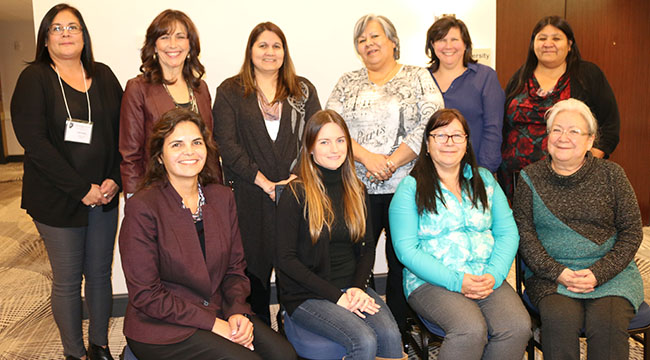First Nations assert jurisdiction over education

By Marci Becking
TORONTO – The 22 First Nations going forward with the Anishinabek Education System made the selection of the Kinoomaadziwin Education Board this week in Toronto.
The decision was made to have four Regional Education Councils with three representatives, making the 12 representatives until April 1, 2018 until it is reviewed again.
For Regional Education Council #1 which includes Biigtigong Nishnaabeg, Long Lake #58, Pic Mobert, Red Rock, and Biinjitiwaabik Zaaging Anishinabek selected Elaine Stewart (Pic Mobert), Lisa Michano (Biitigong Nishnaabeg) and Judy Desmoulin (Long Lake #58) were selected.
Regional Education Council #2 (former regions #2 and #3 combined), which includes Atikameksheng Anishinawbek, Mississauga #8, Sheshegwaning, Aundeck Omni Kaning and Zhibaahaasing selected Janice Cada (Sheshegwaning), Jeanne Naponse (Atikameksheng) and Debbie Mayer (Mississauga #8) as board members
Regional Education Council #3 (formerly #4) which includes Henvey Inlet, Dokis, Nipissing, Wasauksing, Wahnapitae, Magnetawan and Moose Deer Point selected Marianna Couchie (Nipissing), Catherine Pawis (Wasauksing) and Nicole King (Moose Deer Point).
Regional Education Council #4 (formerly #5) which includes Chippewas of Rama, Mississaugas of Scugog, Chippewas of Georgina Island, Aamjiwnaang, and Munsee Delaware selected Evelyn Ball (Rama), Lauri Hoag (Georgina Island) and Vicki Ware (Aamjiwnaang) as board members.
Board director Lauri Hoag has high hopes for the Anishinabek Education System.
“It is our hope to see an Anishnaabe empowered body that can effectively and efficiently assist communities smoothly transition to an education self-government system that will allow more meaningful education programs and plentiful resources for our students.”
Debbie Mayer, board director from Mississaugi, says she is hoping for unity moving forward.
“After being involved in the education system imposed upon First Nations by the federal government, this new, innovative and self-directed agreement will be beneficial for my grandchildren and those next generations to come,” says Mayer. “There is still much work to do ensure there is on-going success of the AES in a cooperative and cohesive way and working in unity going forward.”
Judy Desmoulin, board director for REC #1 says that she is happy to move forward in education.
“We are in a very exciting time,” says Desmoulin. “All of our perseverance, pushing and pulling over the years has come to fruition! We have come a long way and the base is set. Now we can continue to build for increased success.”
Board director Catherine Pawis says that the KEB is founded upon and is empowered by the strong communities that it represents.
“It will build upon the hard work and accomplishments of the Anishinabek Nation in creating, collectively, an education system that is uniquely suited to and responsive to the needs and aspirations of our communities.”
Request for proposals will be going out to find out where the Anishinabek Education System office will be housed. The permanent home for the Kinoomaadziwin Education Body staff will be required to be in a First Nation that is in the Anishinabek Education System.
The next step for the First Nations is to develop and ratify their own Education Law by April 1, 2018.
Legal Counsel Tracey O’Donnell reminds us that First Nations have jurisdiction over education.
“The negotiations were about Canada to recognize the jurisdiction we already have,” says O’Donnell. “Anishinabek First Nations have full authority to make decision of First Nation education. Education is our responsibility for our members. First Nations control the Anishinabek Education System, not Canada.”

